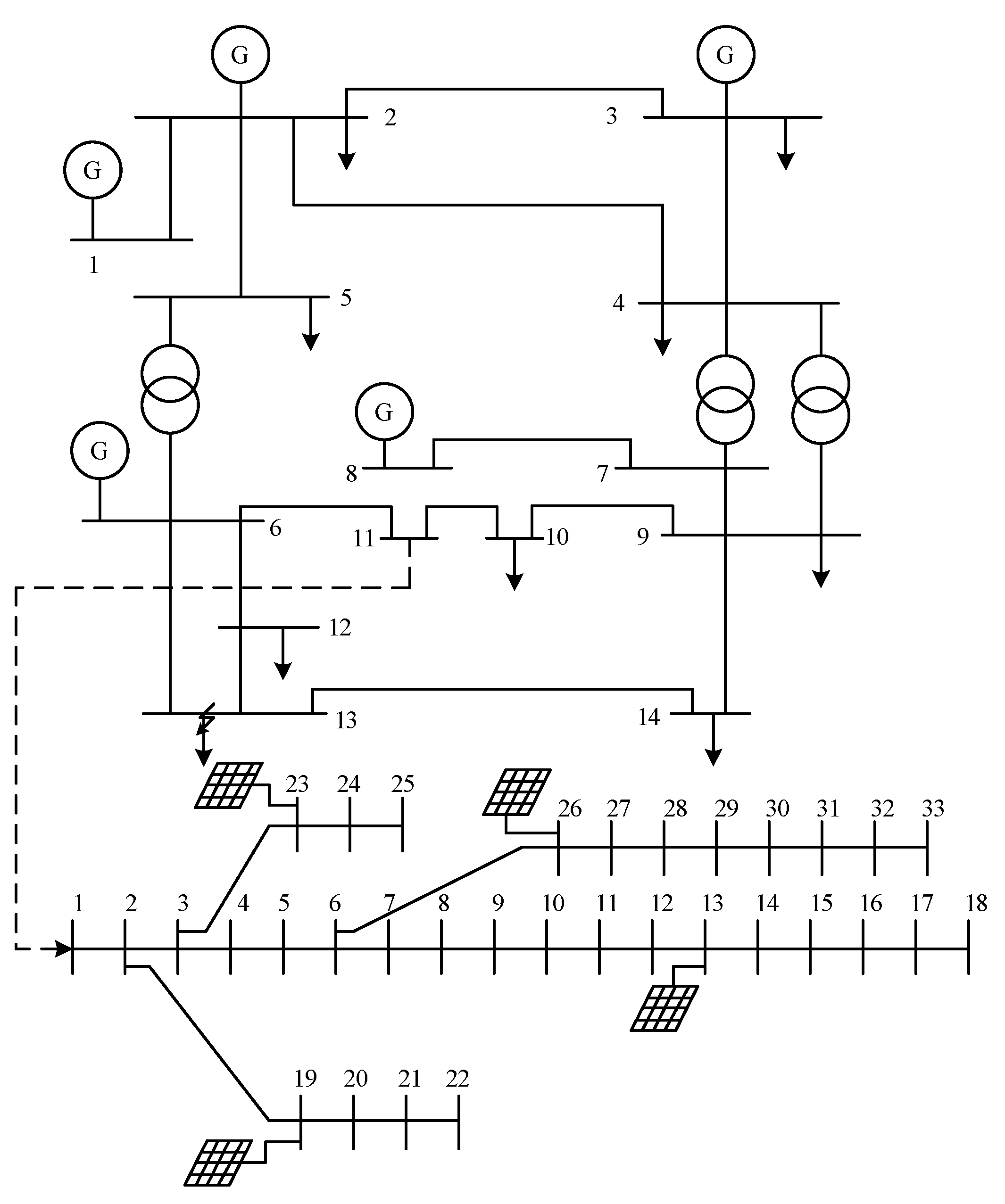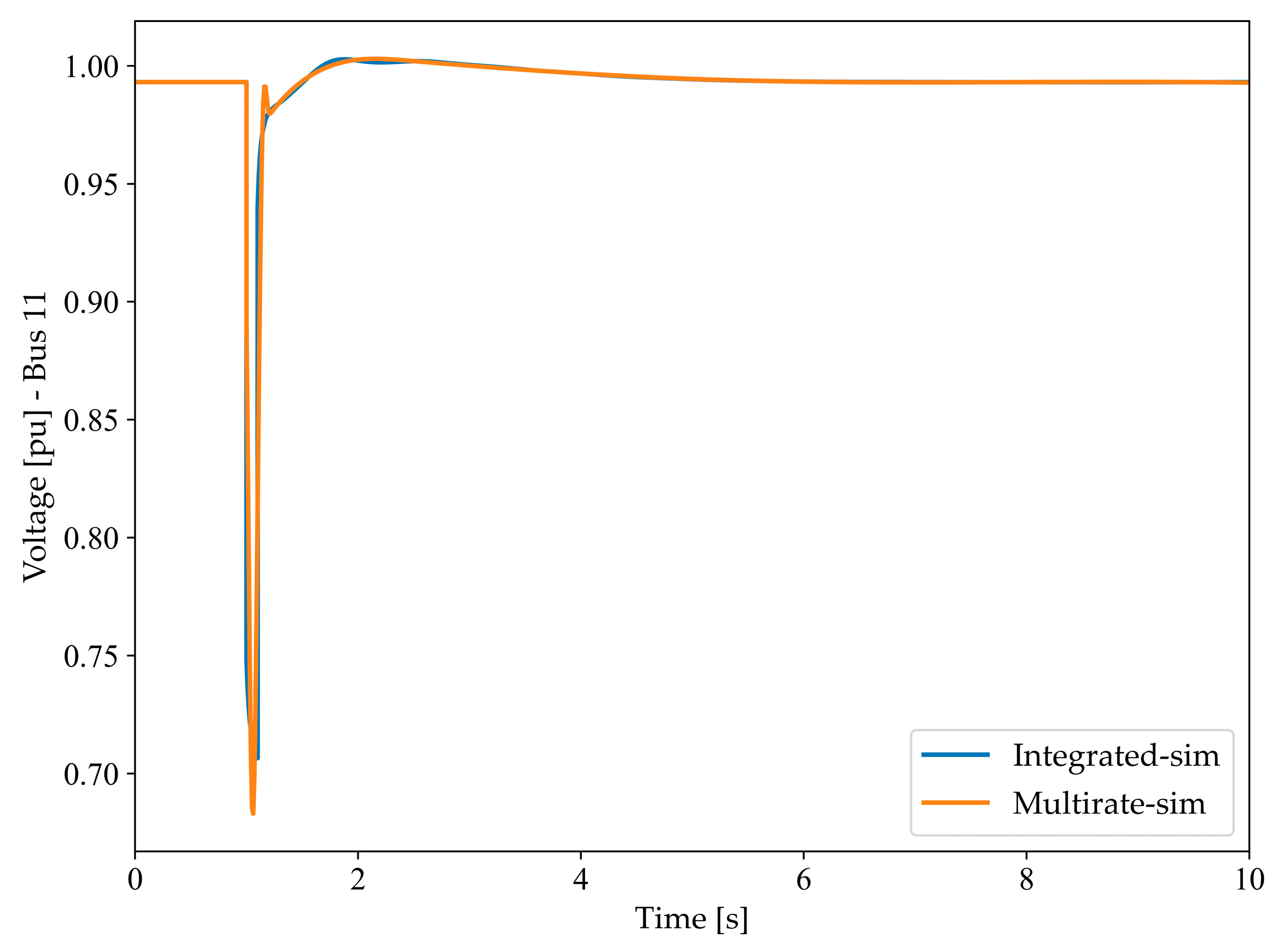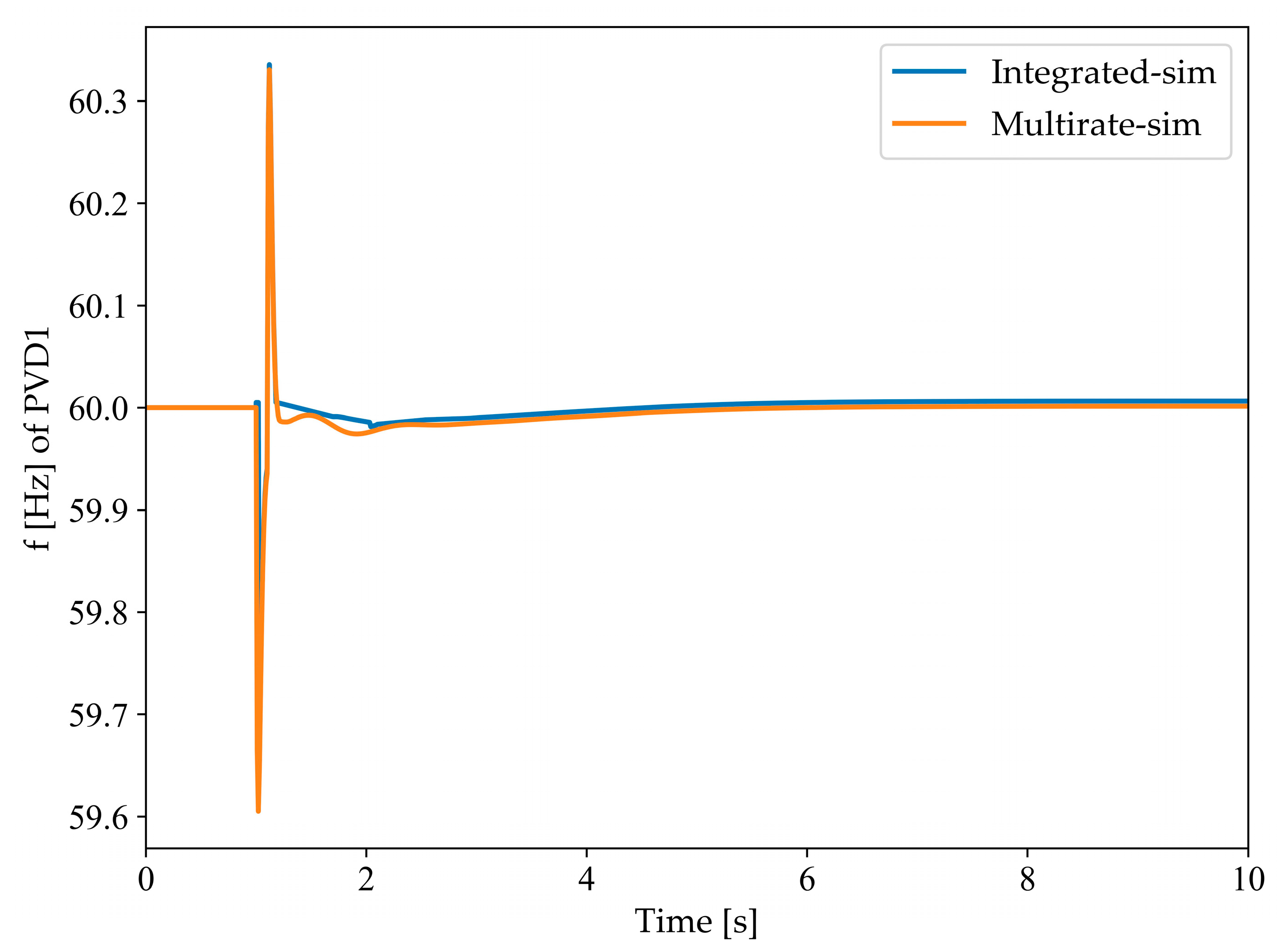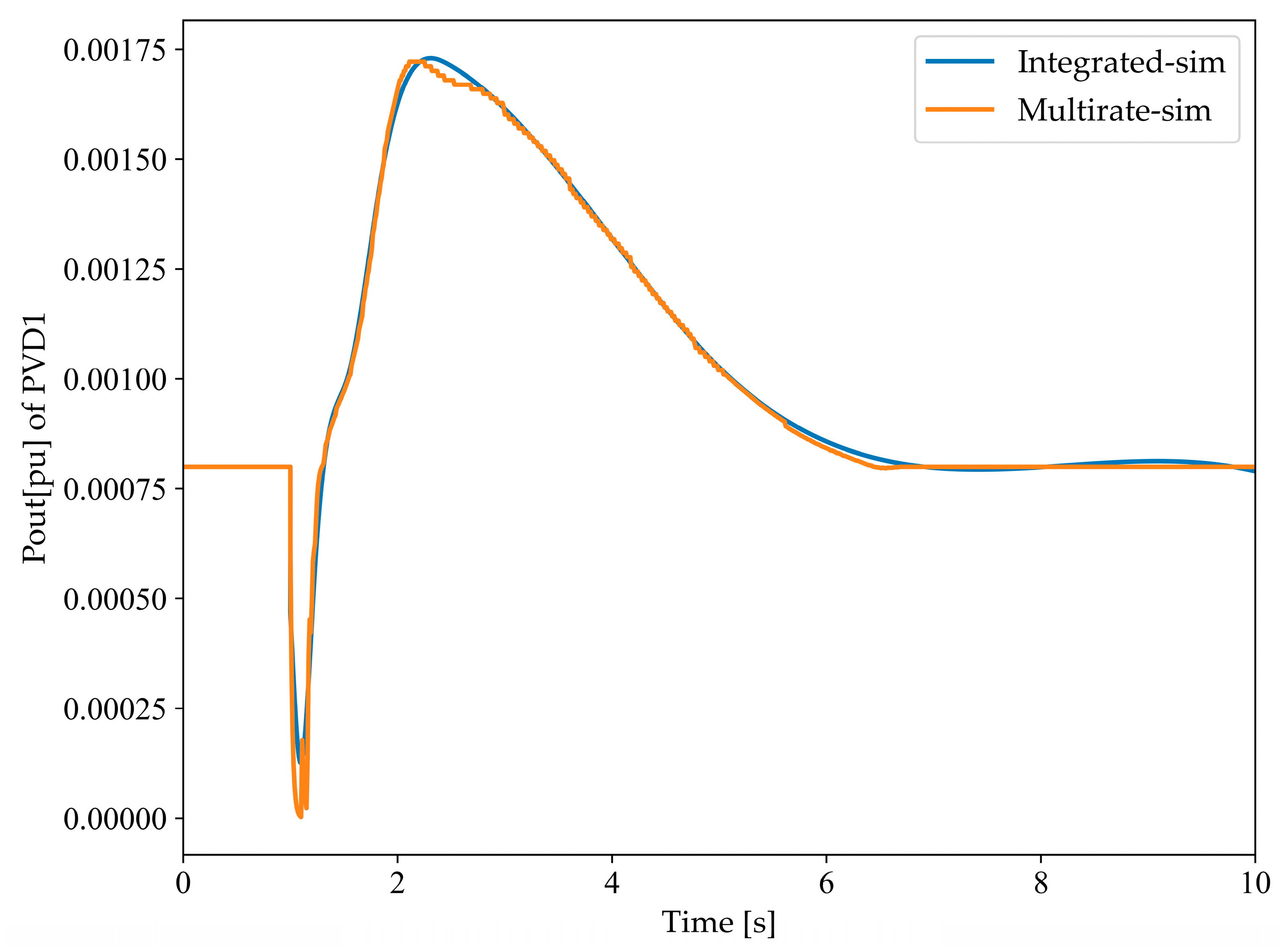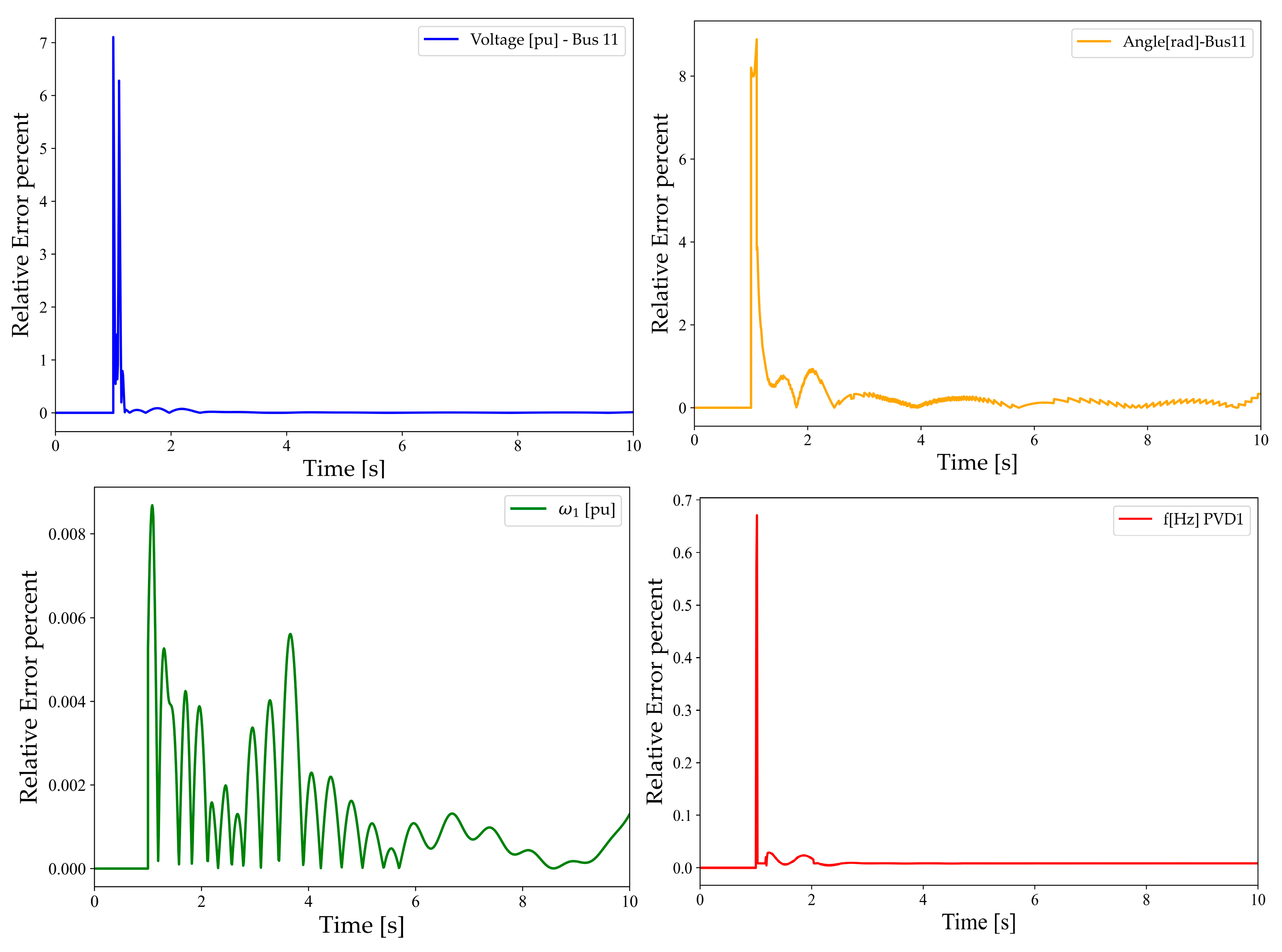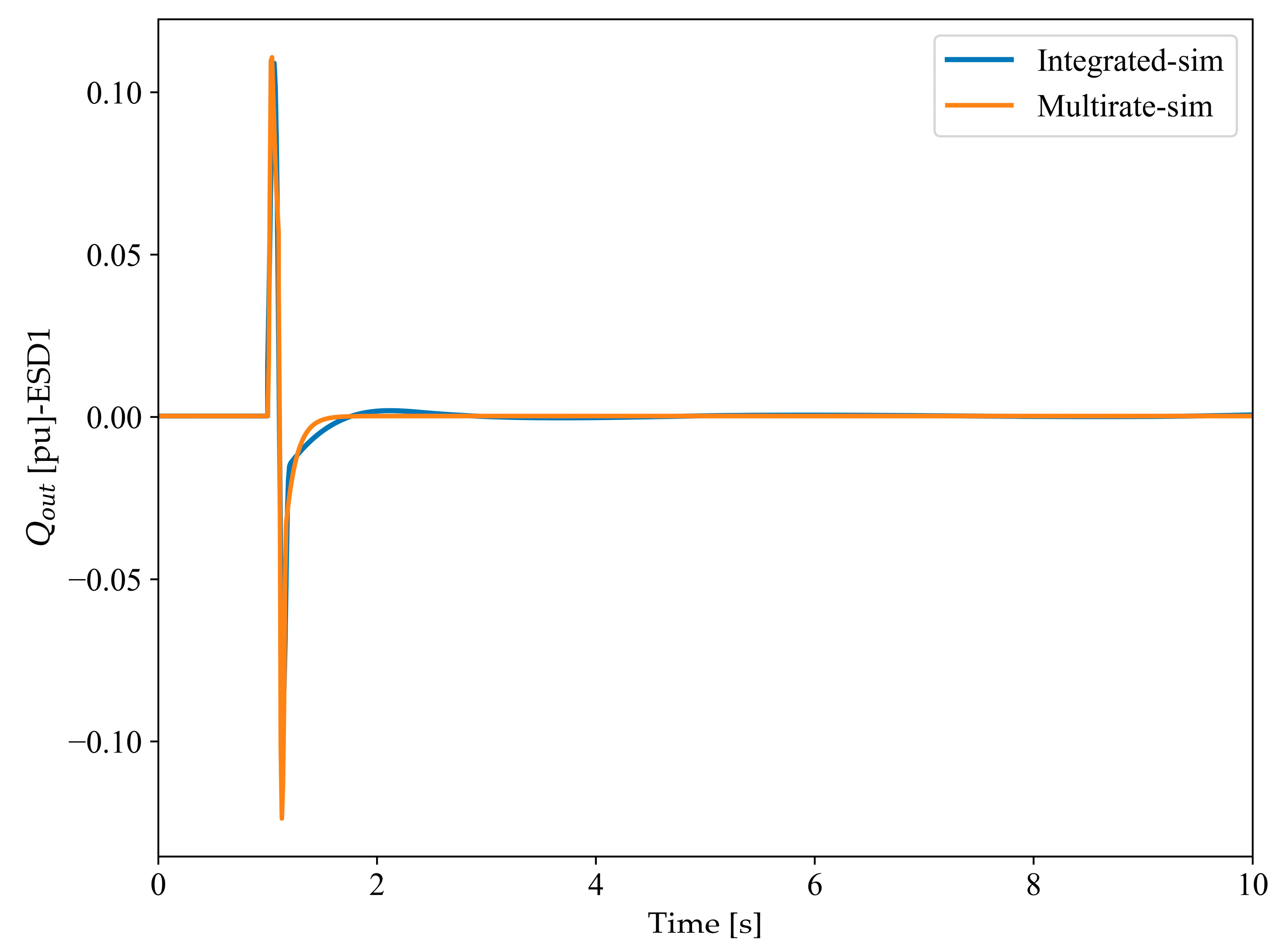This section introduces the multi-rate dynamic simulation for power systems. Firstly, the limitations of the traditional TDS method for multi-rate simulation are discussed. Then, a modified TDS method is proposed to apply on the multi-rate interfaces. The ability of this method to enhance simulation efficiency has already been theoretically verified. Moreover, approaches are presented to address numerical instability issues due to distinct tolerance thresholds for limits of varying systems. Finally, this paper introduces a multi-area data exchange method, which enables data exchange without changing the main dynamic simulation algorithm, making it more universally applicable for simulation software.
2.1. The Modified TDS Method
A multi-rate simulation was proposed, which involves dynamic simulations of systems on varying time scales, including rapid electromagnetic transients and slow mechanical transients [
23]. However, traditional simulation software for dynamic simulation often underperforms due to the design of its inherent algorithm in handling multi-rate simulations of power systems, which might be attributed to the fact that their design and implementation mainly focus on steady-state and transient analysis of power systems, without specific optimization for multi-rate simulations. Such a limitation could impact the accuracy and efficiency of simulations involving dynamics across various time scales [
24]. A thorough investigation into Python open-source software reveals that the initialization process for TDS fundamentally relies on the outcomes of power flow computations. This inherent design presents a significant obstacle when adapting it for multi-rate simulations. Specifically, if an attempt is made to initialize information interactively across different systems to facilitate multi-rate simulation at each step, the interface data input into the system would be superseded by the initialization data generated from each power flow result [
25]. This poses a fundamental constraint, making the direct application impractical for multi-rate simulation scenarios.
In order to overcome the aforementioned problem, this paper presents a modified TDS method that enables multi-rate simulation. The modification entails a significant change to the dynamic simulation program, which overcomes the inherent limitations in the TDS of the software’s built-in algorithms. The initial exchange of the multi-rate simulation proceeds by running programs separately and interacting via input–output files. However, starting from the first exchange, subsystem simulations do not initialize, and necessary data such as voltage are exchanged at the interface, with all other data remaining unchanged from the previous step size simulation. This ensures that the second exchange is based on the first, with subsequent processes following in an iterative fashion to complete the simulation. This change allows for the exchange of information between different systems, thus facilitating multi-rate simulation. This modification not only resolves the existing limitations without altering the original functionality of the software, but also expands its capabilities, transforming it into a more versatile tool for power system simulation. Below is the mathematical formulation of the modified TDS method for multi-rate simulation.
Suppose we have two subsystems, Subsystem 1 and Subsystem 2. Each subsystem can be mathematically represented by a set of differential algebraic equations (DAEs) [
26]:
For Subsystem 2:
where
x denotes the state variables,
y represents the algebraic variables,
u is the system input, and
f,
g are system functions describing the dynamic and algebraic behaviors of the system, respectively.
In traditional dynamic simulation methods for power systems, system initialization is typically achieved by solving a power flow problem. The results of the power flow provide a steady-state solution that matches actual operating conditions, which will serve as the initial conditions for the dynamic simulation. This includes the initial voltage and phase angle for each bus, as well as the initial state of the generators, as shown in Equations (5) and (6):
In Equations (5) and (6),
,
and
,
represent the initial states of subsystems 1 and 2 for each simulation step and the state values obtained from the initialization process of the flow results, respectively. The numerical solution method used in this paper employs a simultaneous solution approach. Its basic process involves first using implicit integration formulas to algebraize the set of differential equations, which together with the set of algebraic equations form a simultaneous nonlinear equation set. Then, Newton’s method is used to solve this set of nonlinear equations, thereby eliminating the need for repeated alternate solving of differential and algebraic equations, as expressed in Equations (7) and (8):
where
is a function dependent on the implicit numerical method used. Equations (7) and (8) are nonlinear and their solution is achieved using Newton’s method. This involves iteratively calculating the increments
and
for the state and algebraic variables, and then updating the actual variables [
24]. During a given iteration denoted by
, the quantities
and
can be formulated by Equation (9) as:
where
is a matrix that depends on the algebraic and state Jacobian matrices of the system. In the trapezoidal rule,
and
can be obtained, as shown in Equation (10):
where
is the identity matrix of the same dimension of the dynamic order of the DAE system and all Jacobian matrices, and
are computed at the current point
.
As described earlier, in the proposed modified method, starting from the second electrical data exchange, the two systems do not need to perform initialization calculation, and directly exchange interface data in the interface program. For example, Subsystem 1 removes the initialization process and instead calls the interface data from the first exchange of Subsystem 2. Other state variables and algebraic variables remain unchanged from the results of the first simulation. Then, Subsystem 1 continues to run the second simulation, as shown in
Figure 1.
This ensures that the results of the second simulation are based on the first, without losing the stability and efficiency of the simulation. When Subsystem 2 transfers power to Subsystem 1, Equations (11) and (12) are utilized to update the electrical data from the previous exchange in advance, and then these are substituted into Equation (9) to uniformly update the state variables and algebraic variables of the system:
Similarly, when Subsystem 1 transfers voltage magnitude and phase angle to Subsystem 2, Equations (13) and (14) are used to pre-update Equation (9):
Assuming bus k of Subsystem 1 is connected to bus m of Subsystem 2, P, Q, V, and θ represent the active power, reactive power, voltage magnitude, and phase angle at the interface, respectively. Δt1 and Δt2 are the time steps for Subsystem 1 and Subsystem 2, respectively. Typically, in the multi-rate simulation method applied to power system analysis, this simulation software offers the functionality to customize the simulation step size for each subsystem. Therefore, the step size for integrating the differential equations can be selected based on the dynamic characteristics of each subsystem, thereby enhancing the simulation efficiency.
2.2. Efficiency Improvement Analysis and Interpolation Correction
The critical consideration for data exchange of multi-rate interface is time synchronization [
27]. However, the proposed method is markedly different from traditional multi-rate methods as it avoids the need for extrapolation approximation calculations. The essence of this approach is the flexible configuration of simulation times and time steps provided by the mature simulation software. In other words, the computational process of the proposed method is sequential, but it ensures the accuracy of the simulation. More specifically, once the simulation of Subsystem 1 is completed, it can be temporarily paused, allowing Subsystem 2 to finish its simulation at a finer time step. Thus, the information exchange can be conveniently carried out again. This method ensures that the data exchange mechanism in the simulation software operates along two independent paths, with information exchange occurring only at the coupling points between the two systems. Consequently, the challenge of time synchronization—a typically significant concern in multi-rate simulations—is effectively mitigated in this study.
It is noteworthy that, once system stability is ensured, the efficiency of the simulation can be enhanced with the reduction of the system matrix order. For instance, if a matrix of order (2n)2 is divided into two subsystems with orders of (0.5n)2 and (1.5n)2, respectively, the overall efficiency, due to the serial process being entirely dependent on the 2.25n2 system, shows a remarkable improvement in simulation efficiency.
However, this introduces the issue of numerical instability caused by the different sensitivities of different systems to port values due to different step sizes [
28]. In line with
Section 2.1, consider two distinct systems, designated as Subsystem 1 and Subsystem 2, each operating at disparate temporal resolutions denoted by
and
, such that
The data exchange between these systems is facilitated via electrical parameters including power (
P), reactive power (
Q), voltage (
V), and phase angle (
θ). The state of System 1 at a given instant
is described by
, whereas the state of System 2 at
is characterized by
. Owing to this temporal granularity mismatch, there may be occasions when System 2 necessitates the state information from System 1 at intermediary points, specifically
where
is a natural number and satisfies
. Employing the state values of
directly at these points might engender numerical instabilities, considering the values may not faithfully convey the actual state of System 1 at the instants
.
In addressing the temporal discrepancy inherent to the interaction between System 1 and System 2, which operate under disparate time step resolutions
and
respectively, an interpolation method is necessitated. This approach seeks to estimate the state of System 1 at an intermediary temporal mark, denoted as
, which lies between two consecutive discrete states
and
. Designating
as the interpolation operator, the estimated state of System 1 at any given point
is thus rendered by
. This interpolation operator can manifest in various formulations, such as linear, polynomial, or spline-based interpolation methodologies [
29,
30]. For instances necessitating linear interpolation, the operator
can be mathematically articulated as Equation (15):
With this construct, System 2 can employ to effectuate an update of its state at the precise time point , thereby attenuating the numerical instabilities promulgated by the incongruence of the time steps.
To analyze the stability of the interpolation method, the local truncation error (LTE) and global error (GE) for states
and
can be considered [
31]. For Systems 1 and 2, the LTE can be expressed as Equation (16):
where
and
are functions describing how the states of Subsystems 1 and 2 evolve over time. The global error, GE, can be computed as Equation (17):
where
and
j represent the iterative steps for Subsystems 1 and 2, respectively. It is essential to ensure that interpolation does not introduce an increase in the GE, which can be ascertained by contrasting the GE observed with and without employing interpolation.


